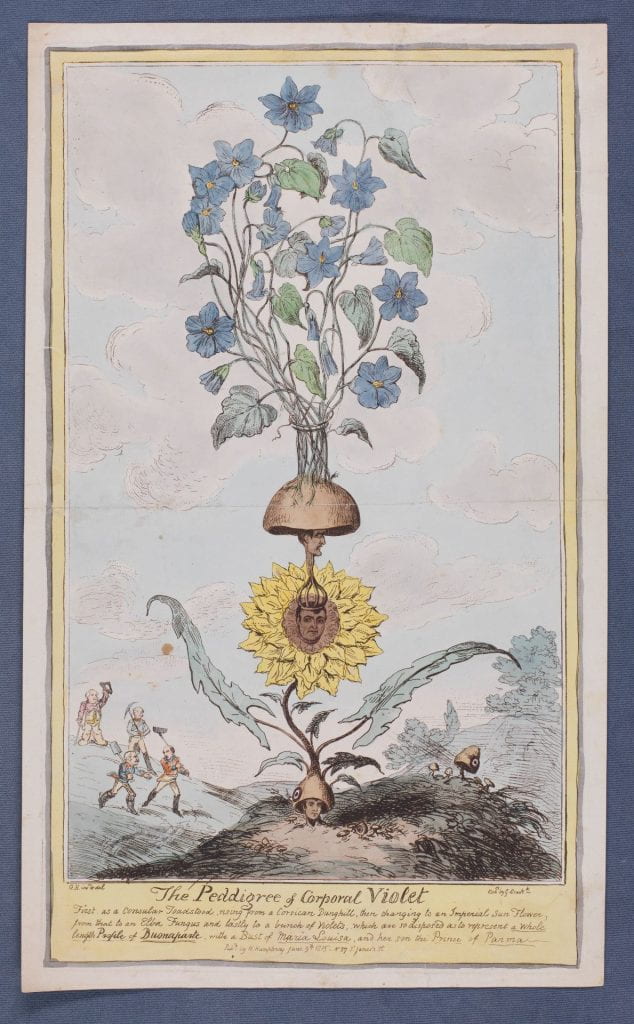
“The base of the design is a dunghill from which rises the head of Napoleon as a young republican officer, not caricatured. His head is covered by a large cup-shaped fungus, decorated with a tricolour cockade and resembling a Cap of Liberty; from its apex ascends a curving stalk, terminating in the large yellow rosette of a sunflower, centred by the head of Napoleon as Emperor, larger than that of the base, and representing an older man; like the lower one it is directed slightly to the right. Below it, leaves project from the stalk, balancing the design. On Napoleon’s head is an arrangement of stamens in the form of an imperial crown. These unite to form the long scraggy neck of the third Napoleon, a head in profile to the right, emaciated and desperate. On this head is a larger fungus than that below, projecting like an enormous hat. From it ascend the stems of a bunch of violets, copied from No. 12511, but with the addition of more flowers, and on a larger scale. It contains the profiles of Napoleon, Marie Louise, and the King of Rome, arranged exactly as in British Museum Satires No. 12511. Smaller fungi sprout from the dunghill, some flat and some conical, like caps of Liberty; on the latter tricolour cockades are indicated. Four little figures are on a slope (left) leading towards the dunghill, prepared to clear it away. In front are Blücher and Wellington, running forward, and talking to each other; one holds a spade, the other a broad hoe. Behind them is the Tsar, shouldering a pickaxe. Behind again stands Louis XVIII, with splayed gouty legs, supported on a crutch. He waves his hat to cheer them on.”–British Museum online catalogue.
- Printmaker: Cruikshank, George, 1780-1842, printmaker.
- Title: The peddigree of Corporal Violet [graphic] / etchd. by G. Cruikk. ; G.H. invt. et del.
- Publication: [London] : Pubd. by H. Humphrey June 9th, 1815 – No. 27 St. James’s St., [9 June 1815]
Catalog Record
815.06.15.02+
Acquired April 2023



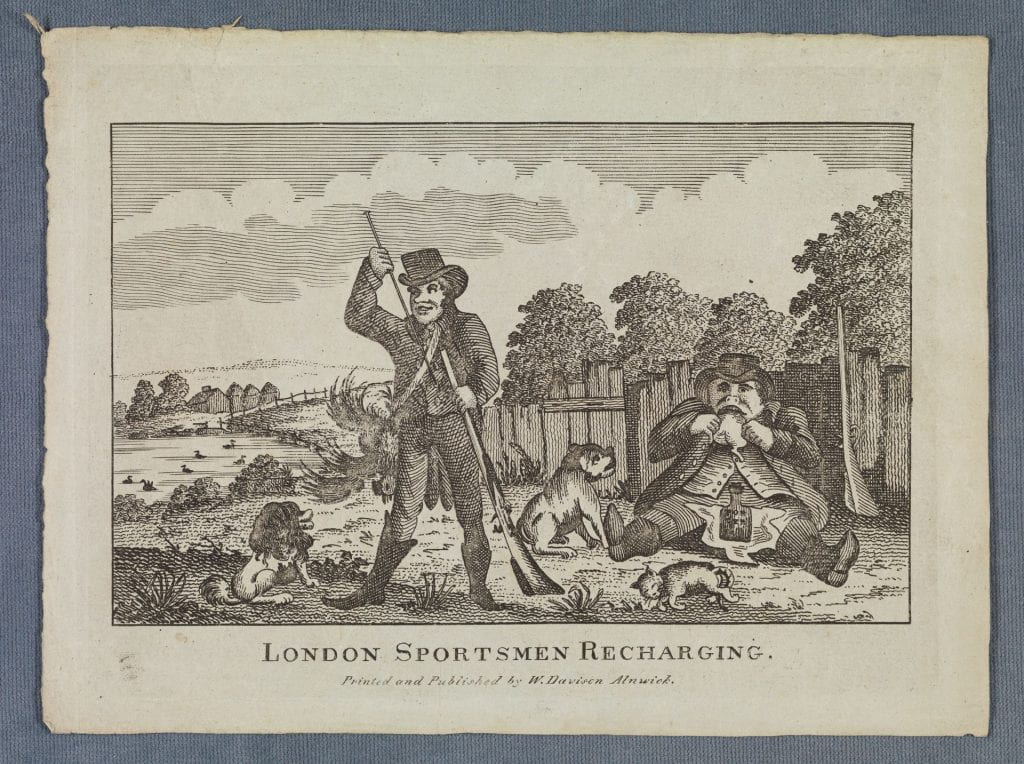
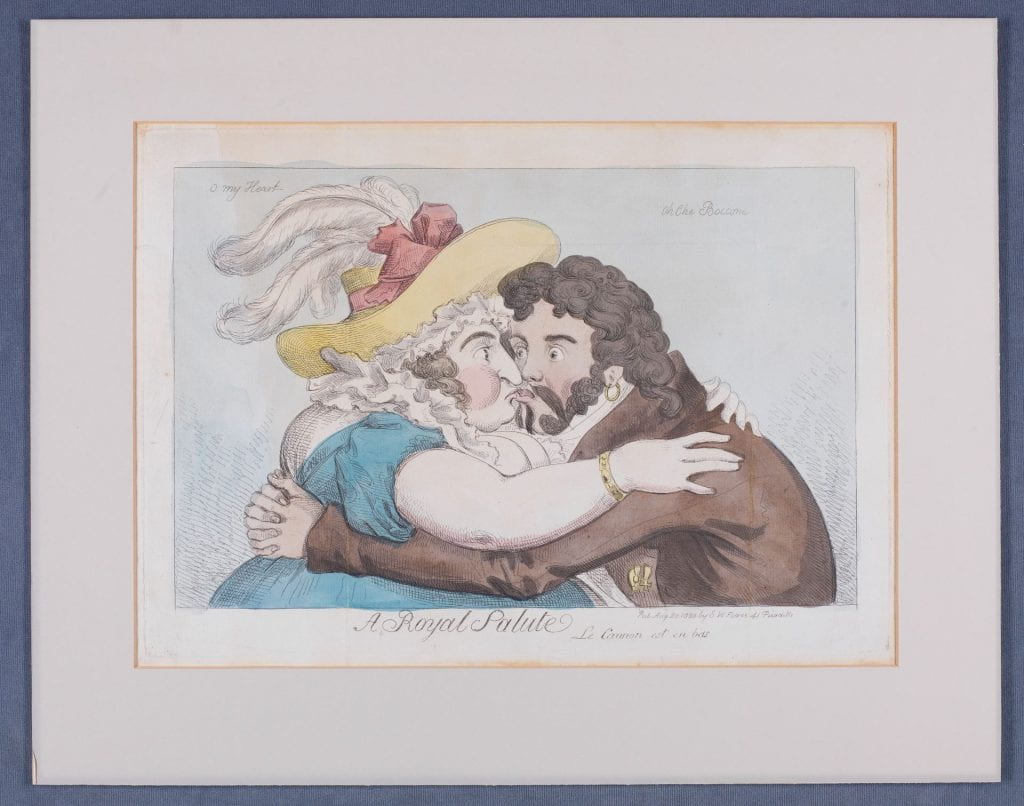

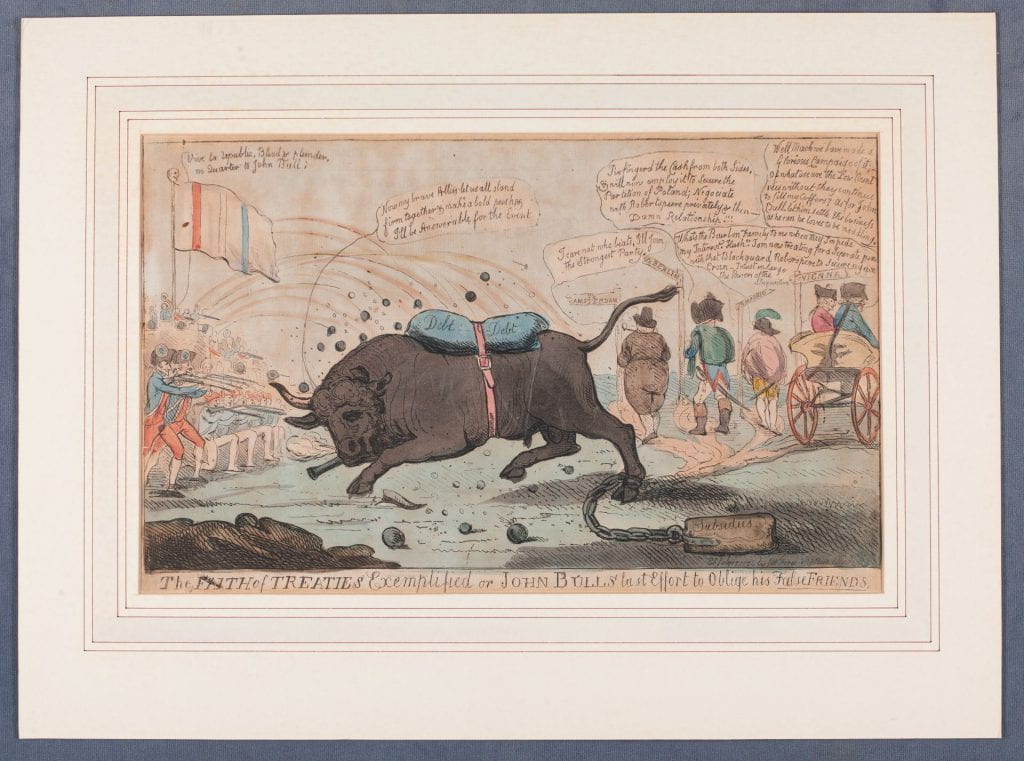
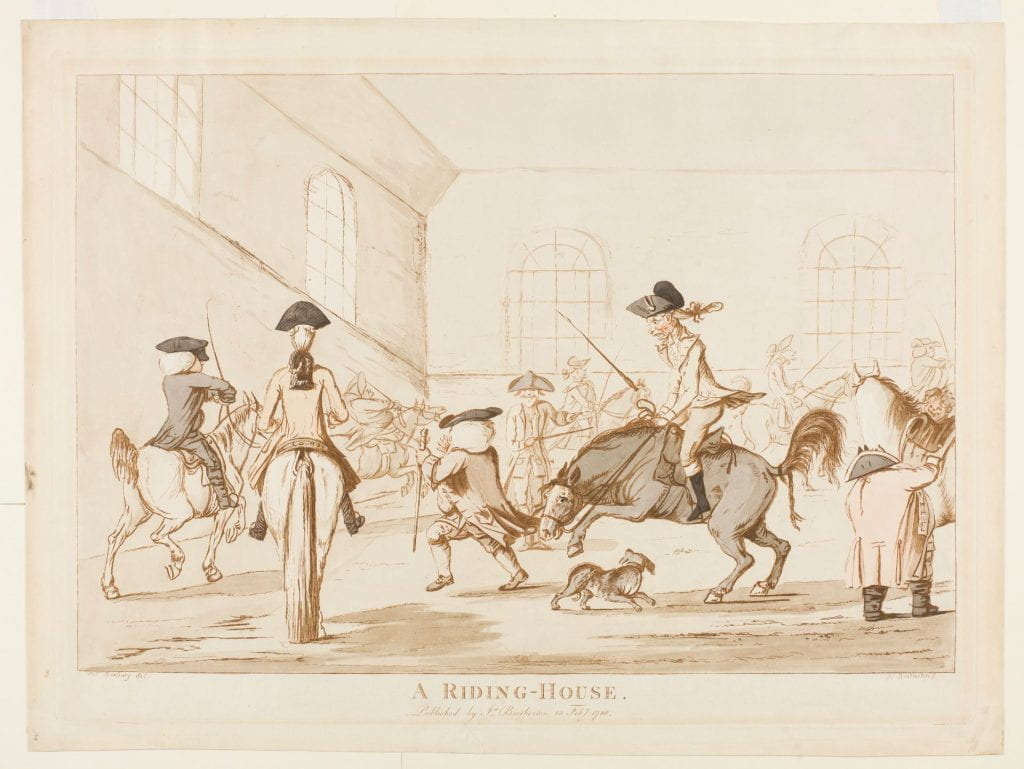 A view of the interior of a riding-school: A number of men riding round in a circle; those in the foreground ride from right to left, those in the background from left to right. The riding-master stands in the centre, pointing with hand and cane, and grinning at a short fat man in a clerical wig who is running across the room, alarmed at the horses. A short obese man in back-view on the extreme right, who is about to mount his horse has been identified as Captain Grose. Next him is a man with a grotesque impression of alarm riding a plunging horse. Among the riders are two with clerical wigs. One horse is galloping, out of control, the others are quietly ambling round. Two sides of a high rectangular room or hall are visible; in each wall are two high arch-topped windows.
A view of the interior of a riding-school: A number of men riding round in a circle; those in the foreground ride from right to left, those in the background from left to right. The riding-master stands in the centre, pointing with hand and cane, and grinning at a short fat man in a clerical wig who is running across the room, alarmed at the horses. A short obese man in back-view on the extreme right, who is about to mount his horse has been identified as Captain Grose. Next him is a man with a grotesque impression of alarm riding a plunging horse. Among the riders are two with clerical wigs. One horse is galloping, out of control, the others are quietly ambling round. Two sides of a high rectangular room or hall are visible; in each wall are two high arch-topped windows. “John Bull, blindfold, stands on a massive truncated pillar holding the beam of a pair of scales. In one scale (left), near the ground, Mrs. Clarke sits composedly among a mass of papers, holding one inscribed My dear Dearest Dearest Darling [see British Museum satires no. 11228, &c.]. The others are inscribed: Sandon, Toyne [Tonyn], Dowler, Omeara, Carter, French, Knight, Clavering. In the other scale the Duke of York swings high in the air, and shouts down to three men on the ground: Save me save me Save my Honour [cf. British Museum satires no. 11269]. They haul hard at ropes attached to his scale, which they tilt sideways so that he is in danger of falling out. One, a drink-blotched bishop wearing a mitre, says: Pull away Pull away the Church is in danger; the other two say: Pull away Pull away we lose all our Places, and Pull away pull away we shall lose our Noble Commander. On the pillar Britannia is depicted seated with her shield and lion; she holds the broken staff of a flag.”–British Museum online catalogue.
“John Bull, blindfold, stands on a massive truncated pillar holding the beam of a pair of scales. In one scale (left), near the ground, Mrs. Clarke sits composedly among a mass of papers, holding one inscribed My dear Dearest Dearest Darling [see British Museum satires no. 11228, &c.]. The others are inscribed: Sandon, Toyne [Tonyn], Dowler, Omeara, Carter, French, Knight, Clavering. In the other scale the Duke of York swings high in the air, and shouts down to three men on the ground: Save me save me Save my Honour [cf. British Museum satires no. 11269]. They haul hard at ropes attached to his scale, which they tilt sideways so that he is in danger of falling out. One, a drink-blotched bishop wearing a mitre, says: Pull away Pull away the Church is in danger; the other two say: Pull away Pull away we lose all our Places, and Pull away pull away we shall lose our Noble Commander. On the pillar Britannia is depicted seated with her shield and lion; she holds the broken staff of a flag.”–British Museum online catalogue.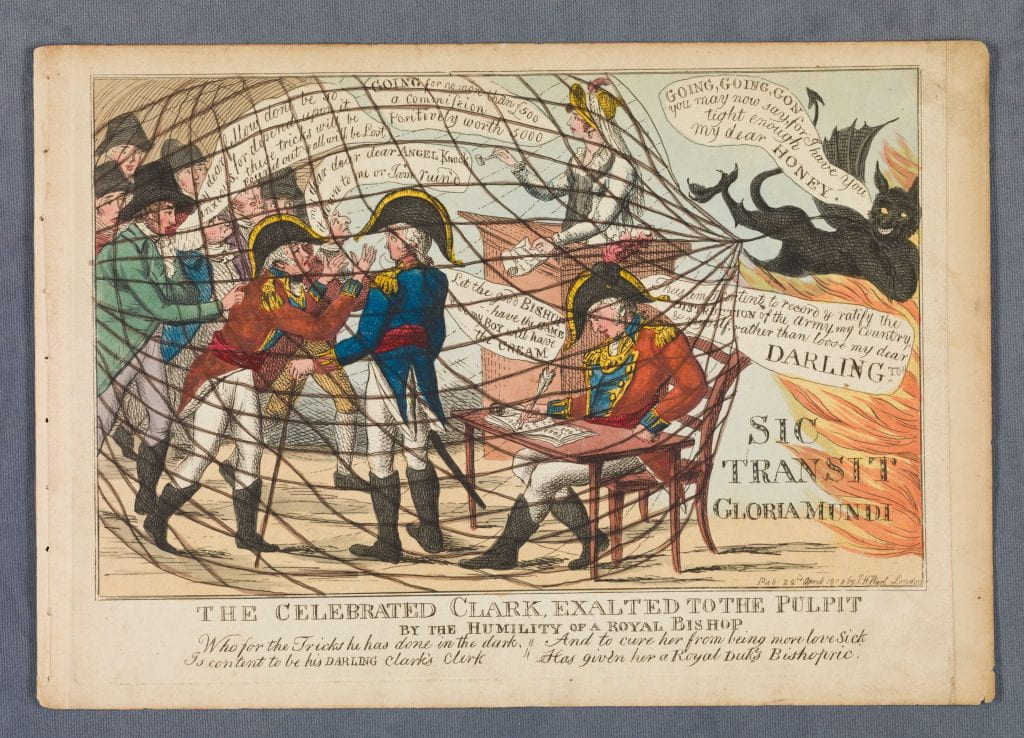 “Mrs. Clarke auctions commissions from a rostrum to a crowd of bidders, while the Duke of York acts as her clerk. All are unconscious of a net in which they are enclosed, and with which the Devil flies off into flames (right). Mrs. Clarke (right), in profile to the left, with raised hammer, holds out a paper headed Commission. She says: Going for no more than £500 a Commission Positively worth 5000. An officer, probably Dowler, see British Museum satires no. 11253, holds out his arms towards her, saying, my dear dear dear Angel Knock it down to me or I am ruin’d. Another says: Let the good Bishop [the Duke, see British Museum satires no. 11227] have the Game & we my Boy will have the Cream. The other applicants are in civilian dress; one says to the bidder: my dear fellow dont be so anxious for depend upon it these tricks will be Found out & all will be Lost. The Duke of York, in uniform, records the bids in a book, his pen resting on the figure 500. He says Thus am I content to record & ratify the Destruction of the Army, my Country & myself, rather than loose my dear DARLING to [cf. British Museum satires no. 11228]. The Devil looks over his shoulder at Mrs. Clarke to say with a baleful grin: Going, Going Gon you may now say, for I have You tight enough my dear Honey.”–British Museum online catalogue.
“Mrs. Clarke auctions commissions from a rostrum to a crowd of bidders, while the Duke of York acts as her clerk. All are unconscious of a net in which they are enclosed, and with which the Devil flies off into flames (right). Mrs. Clarke (right), in profile to the left, with raised hammer, holds out a paper headed Commission. She says: Going for no more than £500 a Commission Positively worth 5000. An officer, probably Dowler, see British Museum satires no. 11253, holds out his arms towards her, saying, my dear dear dear Angel Knock it down to me or I am ruin’d. Another says: Let the good Bishop [the Duke, see British Museum satires no. 11227] have the Game & we my Boy will have the Cream. The other applicants are in civilian dress; one says to the bidder: my dear fellow dont be so anxious for depend upon it these tricks will be Found out & all will be Lost. The Duke of York, in uniform, records the bids in a book, his pen resting on the figure 500. He says Thus am I content to record & ratify the Destruction of the Army, my Country & myself, rather than loose my dear DARLING to [cf. British Museum satires no. 11228]. The Devil looks over his shoulder at Mrs. Clarke to say with a baleful grin: Going, Going Gon you may now say, for I have You tight enough my dear Honey.”–British Museum online catalogue.